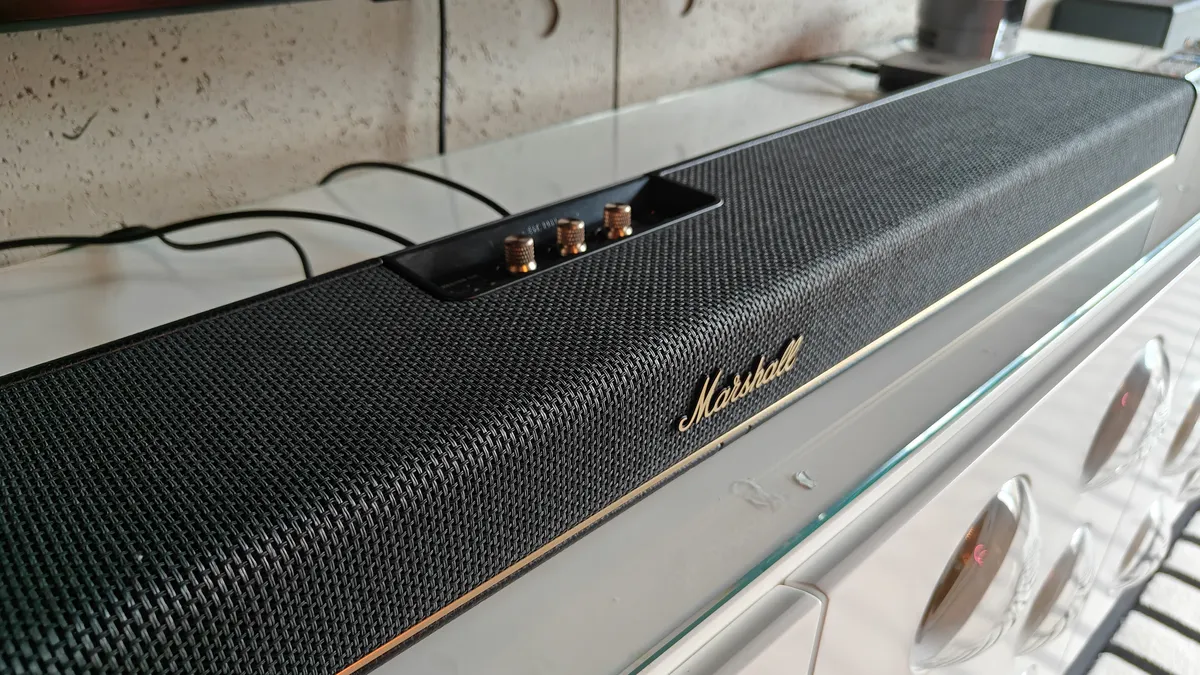
If you’re on the hunt for one of the best soundbars available, the Sonos Arc Ultra has likely made it to your shortlist. This soundbar has received a stellar five-star rating in our review, establishing itself as a top contender in the market. However, a new player has entered the scene: the Marshall Heston 120. Known for its iconic amplifiers and audio equipment, Marshall is now venturing into the competitive realm of soundbars, promising a blend of its rich rock heritage and modern audio technology. In this article, we will compare these two premium soundbars to see how they stack up against one another.
The Marshall Heston 120 is priced at $999.99 / £899.99 / AU$1799, while the Sonos Arc Ultra has an official retail price of $999 / £999 / AU$1799. At the time of this writing, the Arc Ultra is available on sale in the UK for £899, bringing both soundbars to nearly identical price points across all markets. The Heston 120 is currently available for pre-order and is set to launch on June 3rd, with wider retail availability beginning on September 16th. Meanwhile, the Sonos Arc Ultra has been on the market since October 2024.
When it comes to design, the Marshall Heston 120 stands out significantly from most soundbars on the market. Measuring 110 x 14.5 x 7.6cm and weighing 7.04kg, the Heston 120 exudes a distinct rock 'n' roll flair. This soundbar features tactile knurled metal knobs on top for adjusting bass, treble, volume, and source selection, staying true to its amplifier heritage. Wrapped in PU leather trims and adorned with a paper fret covering and brushed metal panels, the design has sparked mixed opinions, with some users loving its bold look while others find it somewhat gaudy compared to the more subtle Sonos design.
On the other hand, the Sonos Arc Ultra adopts a minimalist aesthetic, measuring 118 x 11 x 7.5cm and weighing 5.9kg. Its design is similar to the original Sonos Arc but comes with subtle refinements, such as a rear ledge for touch controls. The perforated metal chassis and soft curves create a sophisticated look that blends seamlessly into any home environment. For users who prefer a more understated soundbar, the Sonos Arc Ultra might be the more appealing option.
The Marshall Heston 120 offers a robust array of connectivity options. It includes HDMI eARC and HDMI pass-through, supporting 4K/120Hz with Dolby Vision HDR. Wireless capabilities encompass Wi-Fi 6 with Google Cast, AirPlay 2, Spotify Connect, and Tidal Connect, alongside Bluetooth 5.3 featuring LE-audio technology, including Auracast. Additional connections include an analogue RCA input, Ethernet (10/100 Mbit), and USB-C. The Heston 120 supports both Dolby Atmos and DTS:X formats, powered by an impressive 11-driver array consisting of five full-range drivers, two tweeters, two mid-woofers, and two subwoofer units in a 5.1.2 configuration.
In contrast, the Sonos Arc Ultra features a 9.1.4-channel configuration with 15 Class D amplifiers driving 14 drivers, including seven tweeters and one unique ‘Sound Motion’ woofer. While it supports Dolby Atmos, it does not offer DTS support. Connectivity on the Sonos is relatively limited, with HDMI eARC but no additional HDMI inputs. However, it does support Bluetooth and is compatible with numerous music streaming services. Sonos’ Trueplay room calibration tool is another notable feature, allowing users to optimize sound based on their room’s acoustics.
At this stage, we can only provide preliminary insights into the sound quality of the Marshall Heston 120, as we have yet to conduct comprehensive tests. However, the Sonos Arc Ultra has proven its worth as a five-star performer, delivering a clean, precise, and spacious sound experience. Its Sound Motion driver excels in bass handling, producing tight and expressive low frequencies. For music, the Arc Ultra maintains excellent precision, even during complex musical passages, making it an engaging option for audio enthusiasts.
Marshall claims that the Heston 120 has been engineered to deliver exceptional sound for both TV and music, with strategically positioned drivers to create a more immersive listening experience. We eagerly anticipate testing its audio performance in our dedicated listening rooms.
The Marshall Heston 120 presents a compelling alternative to the Sonos Arc Ultra, especially considering their similar price points. Beyond its striking design, the Heston 120 offers extensive connectivity options, including HDMI pass-through and DTS:X support, which the Sonos lacks. Additionally, the Heston 120 features physical controls and a repairable design, which may appeal to eco-conscious consumers.
Conversely, the Sonos Arc Ultra boasts proven five-star sound performance, a refined, minimalist design, and compatibility with existing Sonos systems, making it a strong choice for current Sonos users. Until we conduct our full testing on the Marshall Heston 120, we reserve our final verdict. Stay tuned for more updates as we delve deeper into the capabilities of these two remarkable soundbars.